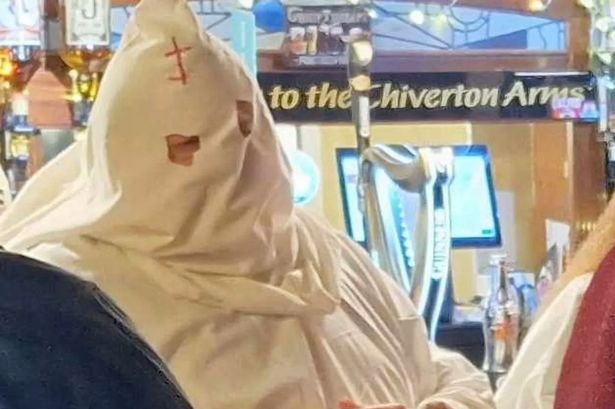The man’s attire, prominently featuring a blood drop cross, immediately signaled his affiliation with the Ku Klux Klan (KKK), a white supremacist hate group with a long and brutal history of violence against Black people in the United States. This symbol, imbued with the hateful ideology of the KKK, represents not just an abstract belief system but a tangible legacy of terror, lynchings, bombings, and systematic oppression aimed at maintaining white dominance and subjugating Black communities. Wearing such a symbol is not simply an act of personal expression; it is a deliberate act of intimidation, a public declaration of racist beliefs, and a disturbing reminder of the ongoing struggle for racial justice in America. The blood drop, in particular, evokes the violent and often fatal consequences of the KKK’s racist ideology, a stark symbol of the bloodshed they inflicted on innocent Black lives.
The KKK’s history is deeply intertwined with the suppression of Black rights and the perpetuation of racial inequality. Emerging after the Civil War, the Klan sought to undermine Reconstruction efforts, intimidate newly freed slaves, and prevent Black Americans from exercising their constitutional rights. Through acts of terrorism, including cross burnings, night rides, and targeted assassinations, the Klan instilled fear and maintained a climate of racial oppression. Their victims were often community leaders, activists, and anyone who dared to challenge the white supremacist order. The blood drop cross, therefore, serves as a chilling reminder of this reign of terror, representing the countless lives lost and the generations traumatized by the Klan’s violent actions. It symbolizes not just the historical atrocities committed by the KKK, but also the persistent threat of white supremacist violence that continues to haunt Black communities.
The choice to wear a symbol so closely associated with racial violence carries significant weight and cannot be dismissed as mere ignorance or individual preference. It represents an active endorsement of the KKK’s hateful ideology and a conscious decision to align oneself with a group responsible for heinous acts of domestic terrorism. Such a display is a direct affront to the principles of equality, tolerance, and respect for human dignity. It contributes to a climate of fear and intimidation, particularly for Black individuals who recognize the symbol and its implications. Furthermore, it normalizes and perpetuates racist ideologies, potentially emboldening other white supremacists and contributing to the ongoing cycle of racial prejudice and discrimination.
Beyond the immediate impact of such a display, the wearing of a KKK symbol also has broader societal implications. It underscores the pervasive nature of racism and the ongoing struggle to dismantle white supremacist ideologies. It demonstrates that these hateful beliefs are not relegated to the fringes of society but can manifest in public spaces, challenging the notion of progress and racial harmony. The visibility of such symbols also serves as a reminder of the importance of continued vigilance and the need to actively combat racism in all its forms. Ignoring or downplaying the significance of such displays allows white supremacist ideologies to fester and gain traction, undermining efforts to build a more just and equitable society.
The man’s choice to wear the blood drop cross is not simply a matter of personal expression; it is a deeply offensive and harmful act with far-reaching consequences. It is a deliberate provocation designed to intimidate and incite fear, perpetuating a legacy of hate and violence. This act underscores the urgent need for continued education and dialogue about the history of racism and the ongoing struggle for racial justice in the United States. It also highlights the importance of holding individuals accountable for their actions and challenging the normalization of hate speech and symbols.
Ultimately, combating white supremacy requires a multifaceted approach that includes addressing the systemic roots of racism, promoting education and awareness, and actively challenging displays of hate and intolerance. The man’s outfit serves as a stark reminder of the work that remains to be done and the importance of standing in solidarity with marginalized communities in the face of prejudice and discrimination. It emphasizes the need for collective action to dismantle white supremacist ideologies and create a society where everyone feels safe, respected, and valued. Silence in the face of such displays is complicity, and it is crucial to speak out against hate and affirm the inherent dignity and worth of all individuals.














